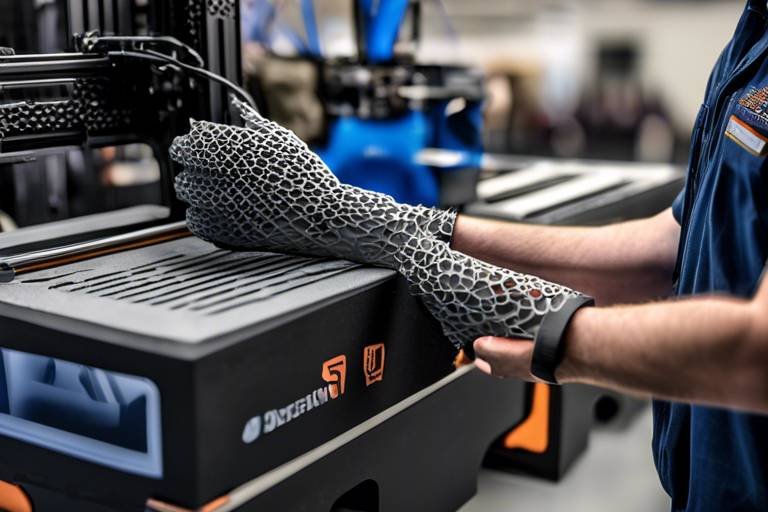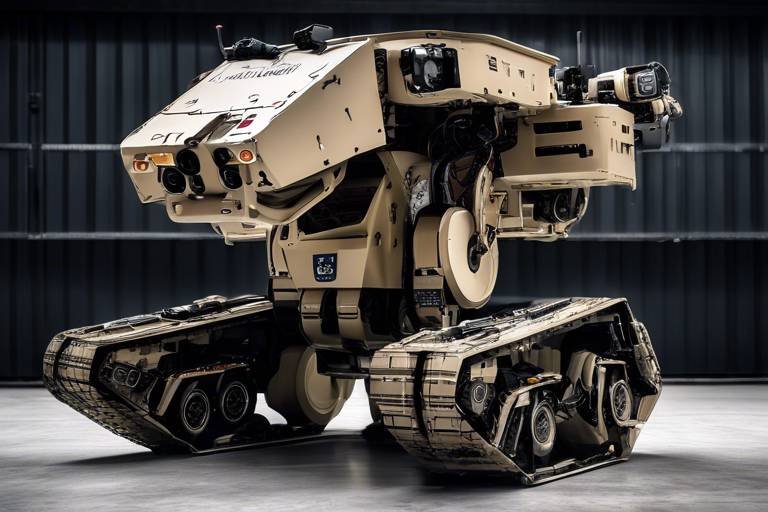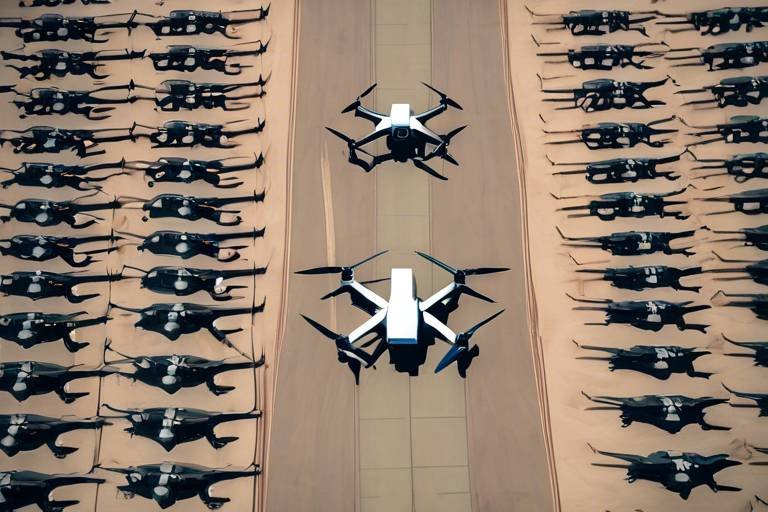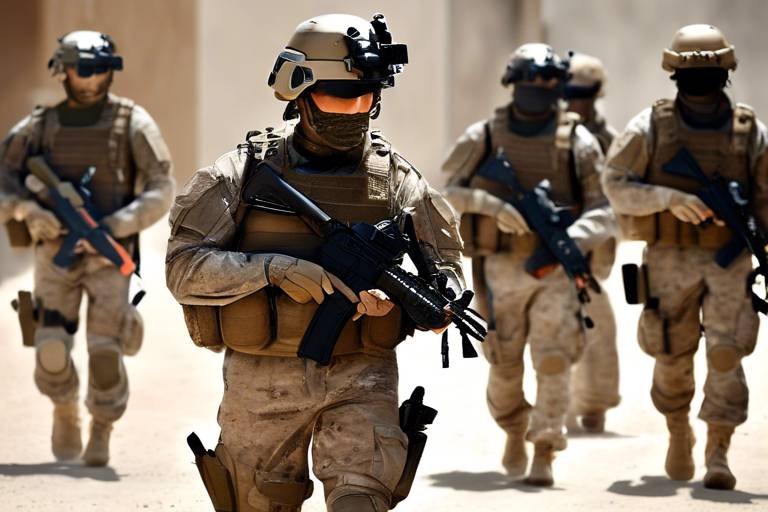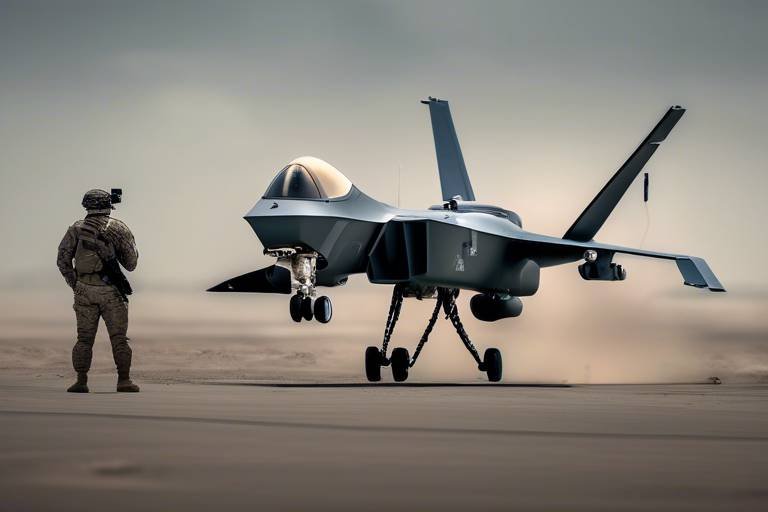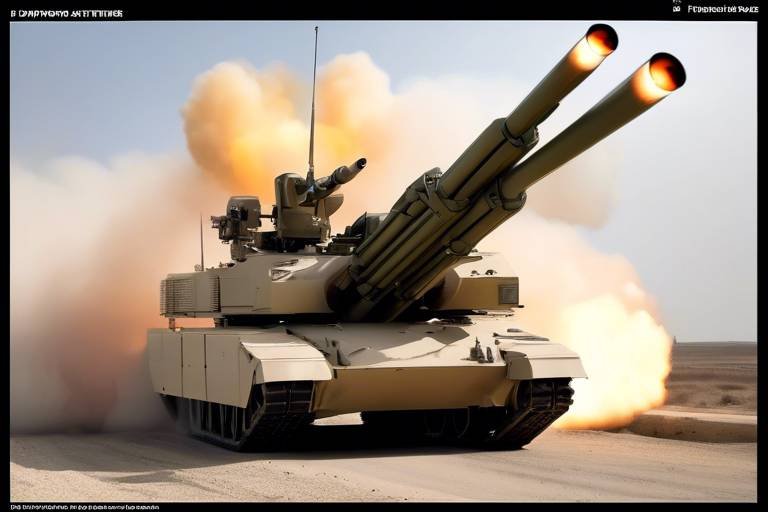How 3D Printing is Impacting Defense Logistics and Supply
In recent years, 3D printing has emerged as a revolutionary technology, reshaping various industries, and the defense sector is no exception. This innovative approach to manufacturing is not just a passing trend; it represents a seismic shift in how military logistics and supply chains operate. Imagine a world where troops in remote locations can produce vital equipment and spare parts on demand, drastically reducing the time and costs associated with traditional supply chains. This article delves into the transformative role of 3D printing in defense logistics and supply chains, highlighting its benefits, challenges, and future implications for military operations.
The journey of 3D printing in the defense realm has been nothing short of remarkable. Initially developed in the 1980s for prototyping, the technology has gradually integrated into various sectors, including military logistics. Early applications were limited to small-scale prototypes, but as the technology advanced, its potential became increasingly apparent. Today, 3D printing can produce everything from simple tools to complex components for advanced weaponry. The evolution has been propelled by the need for faster production times and the ability to customize parts, which traditional manufacturing methods struggle to achieve.
3D printing offers a plethora of advantages for military supply chains, revolutionizing how defense operations are conducted. One of the most significant benefits is the potential for cost reduction. By allowing for rapid prototyping and on-demand production, 3D printing enhances operational efficiency and reduces the reliance on extensive supply chains. This capability can be particularly beneficial in crisis situations where time is of the essence. The ability to produce parts locally means that military units can respond more swiftly to their needs, ensuring that they are always equipped for any challenge.
When it comes to production costs, 3D printing is a game changer. By minimizing material waste and lowering transportation expenses, it leads to significant savings for defense budgets. Traditional manufacturing often involves cutting large blocks of material down to size, resulting in substantial waste. In contrast, 3D printing uses only the material necessary for the part being produced, which not only saves money but also has environmental benefits. This reduction in waste is crucial, especially as the military seeks to adopt more sustainable practices.
One of the key advantages of 3D printing is its ability to reduce material waste. Traditional manufacturing processes can be wasteful, producing off-cuts and excess materials that end up in landfills. With 3D printing, the process is additive, meaning that material is only used where it is needed. This not only conserves resources but also lowers costs associated with purchasing and disposing of excess materials. The environmental impact is significant, aligning with the military's goals of sustainability.
Transportation costs are another area where 3D printing shines. By enabling local production, the need for long-distance shipping is drastically reduced. This not only cuts down on transportation expenses but also shortens delivery times. In military operations, where every second counts, the ability to produce parts on-site can be the difference between mission success and failure. For instance, imagine a scenario where a critical component fails in the field; with 3D printing, troops can swiftly manufacture a replacement rather than waiting days for a shipment to arrive.
3D printing also accelerates the prototyping process, allowing for quicker iterations and fostering innovation in military equipment design. Traditional prototyping methods can take weeks or even months, but with 3D printing, prototypes can be created in a matter of hours. This rapid turnaround allows military engineers to test and refine their designs much more efficiently. Moreover, the ability to experiment with unconventional designs can lead to breakthroughs in technology that enhance military capabilities.
Despite its numerous benefits, the implementation of 3D printing in defense logistics is not without challenges. Regulatory hurdles, technology limitations, and security concerns pose significant obstacles that must be addressed. As the military seeks to adopt this innovative technology, it must navigate a complex landscape of compliance and security requirements to ensure that the technology is deployed safely and effectively.
Adhering to military regulations and standards when adopting 3D printing technologies can be complex. The military operates under strict guidelines to ensure the safety and reliability of its equipment. Integrating 3D printing into these established processes requires careful consideration and adaptation to meet compliance standards. This can slow down the adoption process, as thorough testing and validation are essential to maintain operational integrity.
Moreover, there are technical challenges associated with 3D printing, including material limitations and the need for secure processes. Not all materials suitable for traditional manufacturing are available for 3D printing, which can limit the types of parts that can be produced. Additionally, security concerns about the unauthorized replication of sensitive equipment must be addressed. The military must implement robust security measures to prevent potential threats associated with 3D printing.
Looking ahead, the future of 3D printing in defense logistics is filled with potential advancements. As technology continues to evolve, we can expect to see improvements in material science, allowing for a broader range of applications. The integration of artificial intelligence and machine learning into the 3D printing process could further enhance efficiency and innovation. The implications for future military operations are profound, as 3D printing could redefine how defense logistics are approached, ultimately leading to more agile and responsive military capabilities.
- What is 3D printing? 3D printing is a manufacturing process that creates three-dimensional objects from a digital file by adding material layer by layer.
- How does 3D printing benefit the military? It offers cost savings, rapid prototyping, reduced material waste, and local production capabilities.
- What challenges does the military face with 3D printing? Challenges include regulatory compliance, technology limitations, and security concerns.
- What is the future of 3D printing in defense? Advancements in materials and integration with AI are expected to enhance the efficiency and capabilities of military logistics.

The Evolution of 3D Printing in Defense
3D printing, also known as additive manufacturing, has come a long way since its inception in the 1980s. Initially, this innovative technology was primarily utilized in the realms of prototyping and design, but over the years, it has gradually carved out a significant niche within defense logistics. Imagine a world where military equipment can be produced on-demand, tailored to specific needs, and delivered right to the battlefield. This is not just a dream; it's becoming a reality thanks to the evolution of 3D printing.
In the early days, 3D printing was mostly confined to small-scale applications. However, as technology advanced, the capabilities of 3D printers expanded dramatically. By the early 2000s, the military began to take notice of the potential benefits of this technology. The U.S. Department of Defense (DoD) started exploring how 3D printing could enhance supply chain efficiency and reduce dependency on traditional manufacturing processes. The integration of 3D printing into defense logistics has been a gradual but steady journey, evolving from basic prototypes to the production of complex parts and even entire systems.
One of the pivotal moments in this evolution was the introduction of metal 3D printing. This breakthrough allowed for the creation of stronger, more durable components that could withstand the rigors of military applications. As a result, the defense sector began to see 3D printing not just as a tool for prototyping, but as a viable method for actual production. The ability to print parts on-site, especially in remote locations, has revolutionized how military operations are conducted. No longer do troops need to rely solely on supply lines that can be vulnerable to disruption; they can now produce necessary components as needed.
Today, the landscape of 3D printing in defense is more dynamic than ever. Various branches of the military are actively investing in this technology, experimenting with everything from drones to vehicle parts. The U.S. Army, for instance, has been at the forefront, conducting numerous trials and pilot programs aimed at integrating 3D printing into their operations. The results have been promising, showcasing not just the feasibility of the technology but also its potential to enhance operational readiness.
As we look forward, the evolution of 3D printing in defense is expected to continue at an accelerated pace. Innovations such as bioprinting for medical applications and the use of advanced materials will likely play a significant role in shaping the future of military logistics. The ability to produce custom solutions in real-time will not only streamline operations but also ensure that military personnel have the tools they need to succeed in diverse environments.
In summary, the journey of 3D printing in defense logistics has been marked by significant milestones and transformative changes. From its humble beginnings to its current status as a game-changer, this technology is poised to redefine how military operations are conducted. As the defense sector continues to embrace 3D printing, we can expect to see even more innovative applications that will enhance efficiency, reduce costs, and ultimately save lives.
- What is 3D printing?
3D printing, or additive manufacturing, is a process that creates three-dimensional objects layer by layer from a digital file. - How is 3D printing used in defense?
It is used for rapid prototyping, on-demand production of parts, and even creating complex systems tailored to specific military needs. - What are the benefits of 3D printing in military logistics?
Benefits include cost reduction, material waste minimization, and the ability to produce parts locally, reducing dependency on long supply chains. - What challenges does 3D printing face in defense?
Challenges include regulatory compliance, technology limitations, and security concerns regarding the replication of sensitive equipment.

Benefits of 3D Printing for Military Supply Chains
When it comes to military operations, efficiency is the name of the game. 3D printing has emerged as a revolutionary technology that is reshaping the landscape of military supply chains. Imagine a world where soldiers in remote locations can produce the parts they need on-demand, without waiting for lengthy supply routes. This is not just a dream; it's becoming a reality. The benefits of 3D printing for military supply chains are profound, and they extend far beyond mere convenience.
One of the most significant advantages is cost reduction. Traditional manufacturing processes often involve extensive supply chains, which can be both time-consuming and expensive. With 3D printing, the need for large inventories is diminished. Instead of stockpiling parts that may or may not be needed, military units can print components as required. This on-demand production capability not only saves money but also reduces the risk of obsolescence, as parts can be produced based on current needs and specifications.
Another key benefit is the ability to rapidly prototype new designs. Think about it: in a fast-paced military environment, the ability to quickly iterate on designs can mean the difference between success and failure. With 3D printing, engineers can create prototypes in a fraction of the time it would take using traditional methods. This speed fosters innovation, allowing for the development of cutting-edge equipment tailored to the unique challenges faced in the field.
Moreover, 3D printing significantly enhances operational efficiency. By enabling local production, military units can respond to needs almost instantly. For example, if a soldier breaks a critical piece of equipment, they can simply print a replacement part right there on-site rather than waiting days or weeks for a replacement to arrive. This capability not only minimizes downtime but also enhances the overall effectiveness of military operations.
To illustrate these benefits, let's take a look at a comparative table that highlights the differences between traditional supply chains and 3D printing:
| Aspect | Traditional Supply Chains | 3D Printing |
|---|---|---|
| Lead Time | Days to weeks | Hours to days |
| Inventory Costs | High | Low |
| Flexibility | Limited | High |
| Innovation Speed | Slow | Fast |
As you can see, the shift towards 3D printing in military supply chains is not just a trend; it's a transformative shift that enhances every aspect of military logistics. The ability to produce parts quickly and efficiently can significantly impact the success of missions, making 3D printing an invaluable asset in the defense sector.
- What types of materials can be used in 3D printing for military applications?
3D printing can utilize a variety of materials including plastics, metals, and composites, tailored for specific military needs.
- How does 3D printing improve sustainability in defense logistics?
By reducing material waste and minimizing transportation needs, 3D printing contributes to more sustainable military operations.
- Are there any risks associated with 3D printing in defense?
Yes, there are concerns regarding security and the potential for unauthorized replication of sensitive components.

Cost Efficiency in Production
When we talk about cost efficiency in production, 3D printing stands out as a game changer in the defense sector. Imagine a world where military supplies can be produced on-demand, right at the point of need. This isn't just a dream; it's becoming a reality thanks to 3D printing. Traditional manufacturing processes often involve long lead times and substantial overhead costs. In contrast, 3D printing drastically reduces these burdens, enabling the military to allocate resources more effectively.
One of the key benefits of 3D printing is its ability to minimize material waste. In conventional manufacturing, materials are often cut away and discarded, leading to significant waste. However, with 3D printing, items are built layer by layer, which means that only the necessary materials are used. This not only conserves resources but also translates to lower costs. For instance, a recent study showed that companies could save up to 30% on material costs by switching to additive manufacturing techniques.
Additionally, the transportation costs associated with military logistics can be staggering. Long-distance shipping of parts and supplies not only incurs hefty fees but also creates delays that can compromise operational readiness. By utilizing 3D printing, military bases can produce essential components on-site. This localized production reduces the need for extensive supply chains and minimizes the time it takes to get critical supplies into the hands of those who need them. Consider this: instead of waiting weeks for a part to arrive from a distant manufacturer, troops can print what they need in a matter of hours. This rapid turnaround can be the difference between success and failure on the battlefield.
In summary, the cost efficiency of 3D printing in defense production is evident in two major areas: material waste reduction and transportation cost savings. By embracing this technology, the military not only saves money but also enhances its operational efficiency, allowing for a more agile response to challenges. The implications are profound—3D printing is not just about creating parts; it's about reshaping the entire landscape of military logistics.
- How does 3D printing reduce material waste? 3D printing builds items layer by layer, using only the material needed for the final product, unlike traditional methods that often cut away excess material.
- Can 3D printing really save on transportation costs? Yes! By producing parts on-site, 3D printing eliminates the need for long-distance shipping, which can significantly lower costs and delivery times.
- What types of materials can be used in 3D printing for defense? Various materials, including plastics, metals, and composites, can be used, depending on the specific requirements of the part being produced.
- Are there any limitations to 3D printing in defense? Yes, there are challenges, such as regulatory compliance, technology limitations, and security concerns regarding the replication of sensitive equipment.

Material Waste Reduction
One of the most significant advantages of 3D printing in defense logistics is its remarkable ability to reduce material waste. Traditional manufacturing processes often involve subtractive methods, where large blocks of material are cut down to create the final product. This not only leads to a substantial amount of scrap material but also contributes to higher costs and environmental concerns. In contrast, 3D printing operates on an additive manufacturing principle, where materials are added layer by layer to build the desired object. This fundamentally changes the game, allowing for a more efficient use of resources.
To put this into perspective, let’s consider the numbers. According to studies, traditional manufacturing can generate up to 90% waste in some processes, whereas 3D printing can reduce this waste to as little as 10% or less. This is not just a win for the environment; it's a win for military budgets too. By minimizing excess material use, defense organizations can allocate resources more effectively, ensuring that funds are directed towards critical areas such as research and development or personnel training.
Moreover, the reduction in material waste also has a positive ripple effect on the environment. With global concerns about sustainability and climate change, the military sector is increasingly looking for ways to minimize its environmental footprint. The shift towards 3D printing technology aligns perfectly with these goals. By using only the necessary amount of material, the defense sector can support initiatives aimed at reducing carbon emissions and conserving natural resources. This creates a dual benefit: enhancing operational efficiency while simultaneously promoting environmental stewardship.
In addition to waste reduction, 3D printing opens doors to using alternative materials that may not have been feasible in traditional manufacturing. For instance, biodegradable materials can be utilized to create components that are not only efficient but also environmentally friendly. This innovation can lead to a new era in military logistics where sustainability is at the forefront, pushing the boundaries of what is possible in defense supply chains.
As we look towards the future, the implications of reduced material waste in defense logistics are profound. Imagine a scenario where military units can print their own supplies on-site, using only the materials they need, when they need them. This capability would not only enhance operational readiness but also ensure that resources are used judiciously, reflecting a forward-thinking approach to military logistics.
- What is 3D printing?
3D printing, or additive manufacturing, is a process that creates three-dimensional objects by layering materials based on digital models. - How does 3D printing reduce material waste?
Unlike traditional manufacturing that often cuts away excess material, 3D printing adds material only where needed, significantly minimizing waste. - What are the environmental benefits of 3D printing?
3D printing reduces material waste, allows for the use of sustainable materials, and lowers carbon emissions associated with transportation and production. - Can 3D printing be used for all military supplies?
While 3D printing is versatile, it may not be suitable for all applications, especially those requiring specific materials or high levels of durability.

Transportation Cost Savings
In the realm of defense logistics, can be a game-changer. Imagine a scenario where military units need a specific part for their equipment, but instead of waiting weeks for delivery from a distant supplier, they can simply print it on-site. This is where 3D printing truly shines. By enabling local production, 3D printing drastically reduces the need for long-distance shipping, which can be both time-consuming and expensive.
When we consider the logistics of transporting materials over vast distances, the costs can quickly add up. For example, transporting a single component from a factory to a remote military base can involve not just the price of shipping, but also insurance, handling fees, and potential delays. According to recent studies, the average cost of shipping military supplies can be broken down into various components, as shown in the table below:
| Cost Component | Estimated Cost |
|---|---|
| Shipping Fees | $500 - $2000 |
| Insurance | $100 - $500 |
| Handling Fees | $50 - $300 |
| Potential Delays | $200 - $1000 |
By utilizing 3D printing technology, these costs can be significantly minimized. Local manufacturing means that the only costs incurred are those associated with the materials used in the printing process, which are often much lower than traditional shipping costs. Furthermore, the time saved in production can lead to enhanced operational readiness, allowing military units to respond to situations more swiftly.
Additionally, the environmental benefits of reducing transportation also cannot be overlooked. Less shipping means a smaller carbon footprint, aligning with the military's increasing focus on sustainability. With the ability to produce parts on-demand, the military can not only save money but also contribute to a greener future.
In conclusion, the advantages of 3D printing in terms of transportation cost savings are clear. By shifting to local production, the defense sector can enhance efficiency, reduce costs, and improve sustainability. As technology continues to evolve, we can expect these benefits to grow even further, revolutionizing how military logistics are managed.
- What are the primary benefits of 3D printing in defense logistics? 3D printing offers cost savings, rapid prototyping, and on-demand production capabilities, enhancing operational efficiency.
- How does 3D printing reduce transportation costs? By enabling local production, 3D printing eliminates the need for long-distance shipping, significantly cutting shipping fees and delivery times.
- Are there any challenges associated with 3D printing in defense? Yes, challenges include regulatory compliance, technology limitations, and security concerns regarding unauthorized replication of sensitive equipment.
- What does the future hold for 3D printing in defense? The future looks promising, with potential advancements in technology that could further streamline logistics and improve military operations.

Rapid Prototyping and Innovation
In the fast-paced world of military operations, speed and innovation are crucial. 3D printing is revolutionizing the way the defense sector approaches prototyping, allowing for a level of agility that was previously unimaginable. Imagine being able to design, tweak, and produce a prototype within days instead of the months it typically takes using traditional methods. This rapid prototyping capability is not just a luxury; it’s a necessity in a field where the stakes are incredibly high and the need for cutting-edge technology is constant.
One of the most significant advantages of 3D printing in military supply chains is its ability to facilitate quick iterations. Engineers and designers can create multiple versions of a component, test them, and make adjustments in real-time, all without the need for extensive retooling or setup. This process fosters a culture of innovation where new ideas can be explored and implemented almost instantly. For instance, if a certain part of a drone isn't performing as expected, engineers can swiftly design an improved version and have it printed and tested within a matter of days.
Moreover, this rapid prototyping is not limited to just one-off designs. The technology allows for the production of customized parts tailored to specific missions or operational needs. This is particularly beneficial in scenarios where standard equipment may not suffice. For example, if a particular mission requires specialized tools or attachments for existing equipment, 3D printing can provide those on-demand, ensuring that troops have exactly what they need when they need it. This capability can be a game-changer in the field, where improvisation and adaptability can mean the difference between success and failure.
Additionally, the integration of 3D printing into military logistics is paving the way for a new era of collaborative innovation. By utilizing cloud-based design platforms, teams across different locations can work together on prototypes in real-time. This collaborative effort not only enhances creativity but also ensures that the best ideas are brought to the forefront, regardless of where they originate. As military operations become more global and interconnected, this kind of teamwork is essential.
To illustrate the impact of rapid prototyping through 3D printing, consider the following table that outlines key benefits:
| Benefit | Description |
|---|---|
| Speed | Reduces prototype development time from months to days. |
| Customization | Enables tailored solutions for specific missions and equipment. |
| Cost-Effectiveness | Minimizes expenses associated with traditional manufacturing processes. |
| Collaboration | Allows teams to work together on designs in real-time, enhancing innovation. |
The implications of these advancements are profound. As military forces continue to adopt and integrate 3D printing technology, we can expect to see a significant shift in how equipment is designed, manufactured, and deployed. This not only improves operational efficiency but also fosters a culture of continuous improvement within defense logistics. In a world where technology is constantly evolving, staying ahead of the curve is essential, and 3D printing is undoubtedly a key player in this transformation.
- What is rapid prototyping? Rapid prototyping is the quick fabrication of a physical part, model, or assembly using 3D computer-aided design (CAD) data.
- How does 3D printing improve military logistics? 3D printing enhances military logistics by enabling on-demand production, reducing lead times, and allowing for customized parts tailored to specific needs.
- What are the cost benefits of 3D printing in defense? 3D printing reduces manufacturing costs by minimizing material waste, lowering transportation expenses, and decreasing the time needed for production.
- Can 3D printing be used for all types of military equipment? While 3D printing is versatile, it may not be suitable for all types of equipment, particularly those requiring high-strength materials or complex assembly.

Challenges of Implementing 3D Printing in Defense
The integration of 3D printing into defense logistics is not without its hurdles. While this revolutionary technology promises significant advantages, it also presents a unique set of challenges that military organizations must navigate. One of the most pressing issues is the regulatory landscape. The defense sector is known for its stringent regulations and compliance requirements, which can make the adoption of new technologies like 3D printing a complex process. Military standards are designed to ensure safety, reliability, and effectiveness, but they can also stifle innovation if not adapted to accommodate new manufacturing methods.
Moreover, the technology itself has its limitations. While we often hear about the wonders of 3D printing, it’s essential to recognize that not all materials are suitable for this method. For instance, certain high-strength alloys or specialized composites may not be easily printable, which could restrict the types of components that can be produced in-house. This limitation can hinder the military’s ability to produce critical parts quickly and efficiently. Additionally, the security concerns surrounding 3D printing cannot be overlooked. The potential for unauthorized replication of sensitive military equipment poses a serious threat. If someone were to gain access to a 3D model, they could create a replica without any oversight, leading to potential breaches in national security.
As we consider these challenges, it’s clear that a multifaceted approach is necessary. Military organizations need to invest in research and development to overcome technological limitations while also working closely with regulatory bodies to create frameworks that support innovation without compromising security. One potential solution could be the establishment of partnerships between defense contractors and technology firms specializing in 3D printing. Such collaborations could lead to the development of new materials and processes that meet military standards while enhancing operational capabilities.
In summary, while the promise of 3D printing in defense logistics is enticing, it’s crucial to address the challenges head-on. The path forward involves not just technological advancements but also a rethinking of regulatory frameworks and security protocols. By proactively tackling these issues, the military can harness the full potential of 3D printing to improve its logistics and supply chains.
- What are the main challenges of implementing 3D printing in defense? The primary challenges include regulatory compliance, technology limitations, and security concerns related to unauthorized replication of sensitive equipment.
- How does 3D printing improve military supply chains? 3D printing enhances supply chains by enabling on-demand production, reducing costs, and accelerating prototyping and innovation.
- What steps can be taken to overcome the regulatory hurdles? Collaboration between military organizations and technology firms can help develop new materials and processes that comply with existing regulations.
- Are there any security measures in place for 3D printing? Yes, it is crucial to implement secure processes and controls to prevent unauthorized access to 3D models and the replication of sensitive equipment.

Regulatory and Compliance Issues
As the military embraces the revolutionary potential of 3D printing, it faces a myriad of regulatory and compliance challenges that could hinder its widespread adoption. The intersection of innovation and regulation is often fraught with complexities, particularly in the defense sector, where compliance with stringent military standards is paramount. The question arises: how can the military navigate these regulatory waters while fully leveraging the benefits of 3D printing?
One of the primary hurdles is the necessity to adhere to existing military regulations, which are often designed with traditional manufacturing processes in mind. These regulations encompass a wide range of factors, including quality assurance, material specifications, and operational safety. As 3D printing technologies evolve, so too must the regulatory frameworks that govern them. This creates a lag, where innovative practices may outpace the regulations that are supposed to guide them. The military must engage in a continuous dialogue with regulatory bodies to ensure that standards evolve in tandem with technological advancements.
Moreover, the compliance landscape is further complicated by the need for rigorous testing and validation of 3D printed components. Unlike traditional manufacturing, where processes are well-established, 3D printing introduces variability that can affect the integrity and performance of military equipment. This necessitates the development of new testing protocols that can accurately assess the quality and reliability of 3D printed parts. The military must invest in research and development to create these protocols, which can be both time-consuming and costly.
Additionally, security concerns play a significant role in shaping regulatory frameworks. The ability to produce sensitive military components on-demand raises questions about intellectual property protection and the potential for unauthorized replication. Safeguarding against these risks requires the implementation of robust security measures throughout the 3D printing process. This includes not only securing the physical printers but also ensuring that digital files are protected from cyber threats. As military operations increasingly rely on advanced technologies, the importance of cybersecurity cannot be overstated.
In conclusion, while the integration of 3D printing into defense logistics holds immense promise, it is accompanied by a host of regulatory and compliance challenges that must be addressed. The military must navigate these complexities with a proactive approach, fostering collaboration between technologists and regulators to create a framework that supports innovation while ensuring safety and security. Only then can the full potential of 3D printing be realized in the defense sector.
- What are the main regulatory challenges associated with 3D printing in defense?
The primary challenges include adherence to military standards, the need for rigorous testing and validation, and addressing security concerns regarding intellectual property. - How does 3D printing affect military compliance protocols?
3D printing introduces variability that necessitates the development of new testing protocols and compliance measures, which can be time-consuming and costly. - What role does cybersecurity play in 3D printing for defense?
Cybersecurity is crucial to protect sensitive digital files and prevent unauthorized replication of military components produced through 3D printing.

Technology Limitations and Security Concerns
As promising as 3D printing technology is, it doesn't come without its share of limitations and concerns. The military's adoption of this innovative manufacturing method faces a myriad of challenges that could hinder its effectiveness in defense logistics. One of the primary technological limitations is the material constraints. While there are various materials available for 3D printing, not all are suitable for high-stress military applications. Traditional manufacturing processes can utilize a wider range of materials, including metals and composites that are engineered for durability and resilience. In contrast, many 3D printed materials may not meet the stringent performance criteria required for critical military components.
Moreover, the quality control of 3D printed items is another significant concern. Unlike conventional manufacturing, where processes are well-established and monitored, 3D printing can sometimes lead to inconsistencies in production. Factors such as printer calibration, material quality, and environmental conditions can all affect the final product. This inconsistency can pose serious risks when dealing with equipment that needs to function flawlessly in high-stakes situations.
In addition to these technological hurdles, there are also security concerns that cannot be overlooked. The ease of replicating complex designs using 3D printing raises the specter of intellectual property theft and unauthorized duplication of sensitive military equipment. Imagine a scenario where an adversary gains access to a 3D model of a crucial component, allowing them to replicate it without ever having to invest in the original research or development. This potential for counterfeiting poses a significant threat to national security.
To address these issues, the military must implement robust security protocols and establish stringent guidelines for the use of 3D printing technologies. This includes ensuring that all designs are encrypted and that access to printing capabilities is tightly controlled. Furthermore, ongoing research and development are essential to enhance the materials used in 3D printing, making them more suitable for defense applications while also ensuring they meet the necessary quality standards.
In summary, while 3D printing offers exciting possibilities for the future of defense logistics, the technology is not without its challenges. From material limitations to security concerns, these issues must be addressed to fully harness the potential of 3D printing in military operations.
- What are the main limitations of 3D printing in defense?
The main limitations include material constraints, quality control issues, and security concerns regarding intellectual property theft.
- How does 3D printing impact military logistics?
3D printing can enhance military logistics by enabling on-demand production and reducing transportation costs, but it also introduces challenges that need to be managed.
- What security measures are needed for 3D printing in defense?
Robust security protocols, including encryption of designs and controlled access to printing capabilities, are essential to prevent unauthorized replication of military equipment.

The Future of 3D Printing in Defense Logistics
The future of 3D printing in defense logistics is not just a distant vision; it's a rapidly approaching reality that promises to revolutionize how military operations are conducted. Imagine a world where soldiers can print essential components on-site, tailored to their specific needs, without waiting for supply chains to deliver parts from thousands of miles away. This isn't science fiction—it's the potential of additive manufacturing, and it's already beginning to reshape the landscape of defense logistics.
One of the most exciting prospects of 3D printing in the military is the ability to create customized equipment on-demand. As conflicts become more dynamic and unpredictable, the need for adaptable solutions grows. With 3D printing, military units can produce parts that are specifically designed for unique missions, enhancing their operational effectiveness. This capability not only increases efficiency but also allows for rapid responses to changing battlefield conditions.
Moreover, the integration of advanced materials into 3D printing processes is set to open new doors. Researchers are continually developing stronger, lighter, and more durable materials that can withstand extreme conditions. The combination of composite materials and 3D printing technology could lead to the creation of next-generation military gear that is both functional and resilient. Think about it: a soldier equipped with armor that is not only lighter but also provides enhanced protection. This is the kind of innovation that can save lives.
Another significant aspect of the future of 3D printing in defense logistics is the potential for decentralized manufacturing. Traditional supply chains often involve complex logistics, which can be vulnerable to disruptions. By leveraging 3D printing, military forces can establish localized production hubs. This means that parts can be produced closer to where they are needed, drastically reducing lead times and increasing the agility of military operations. In a world where rapid response can mean the difference between success and failure, this capability is invaluable.
However, the journey towards full-scale adoption of 3D printing in defense logistics is not without its challenges. As we look ahead, it is crucial to address the regulatory frameworks that govern military manufacturing. Ensuring compliance while fostering innovation will be a delicate balancing act. Additionally, the military must invest in training personnel to operate and maintain 3D printers effectively, ensuring that they can leverage this technology to its fullest potential.
Furthermore, as 3D printing technology evolves, so too must the security measures surrounding it. The risk of unauthorized replication of sensitive military equipment is a legitimate concern. Therefore, developing robust security protocols will be essential to safeguard against potential threats. This includes implementing secure software and hardware solutions that prevent unauthorized access to 3D printing files and designs.
In conclusion, the future of 3D printing in defense logistics is bright and full of possibilities. As we continue to push the boundaries of technology, the military stands to gain immensely from these advancements. From enhancing operational efficiency to fostering innovation and improving supply chain resilience, the implications are profound. As we embrace this technology, we must also remain vigilant about the challenges it presents, ensuring that we navigate them wisely to unlock the full potential of 3D printing in defense.
- What are the primary benefits of 3D printing in defense logistics?
3D printing offers numerous benefits, including cost savings, rapid prototyping, and the ability to produce customized parts on-demand, which enhances operational efficiency.
- How does 3D printing reduce material waste?
3D printing uses additive manufacturing techniques that build objects layer by layer, significantly minimizing excess material compared to traditional subtractive manufacturing methods.
- What security concerns are associated with 3D printing in the military?
Security concerns include the risk of unauthorized replication of sensitive equipment, necessitating robust security measures to protect 3D printing files and designs.
- How might 3D printing change the future of military operations?
3D printing could lead to decentralized manufacturing, allowing military units to produce parts on-site, thereby improving response times and operational flexibility.
Frequently Asked Questions
- What is 3D printing and how does it relate to defense logistics?
3D printing, also known as additive manufacturing, is a process that creates three-dimensional objects from digital files. In defense logistics, it allows for the rapid production of parts and equipment, significantly enhancing supply chain efficiency and responsiveness.
- What are the main benefits of using 3D printing in military supply chains?
The primary benefits include cost efficiency, reduced material waste, rapid prototyping, and on-demand production capabilities. These advantages help streamline operations, minimize delays, and ultimately save money for defense budgets.
- How does 3D printing reduce manufacturing costs?
3D printing minimizes material waste by using only the necessary amount of resources to create an object. This, combined with reduced transportation costs from local production, leads to significant savings in overall manufacturing expenses.
- What are the challenges of implementing 3D printing in defense?
Challenges include navigating regulatory and compliance issues, overcoming technology limitations, and addressing security concerns related to the potential unauthorized replication of sensitive military equipment.
- How does rapid prototyping work in the context of 3D printing?
Rapid prototyping allows military designers to quickly create and test prototypes of equipment. This speed enables faster iterations and fosters innovation, allowing for more effective and advanced military solutions.
- What future advancements can we expect in 3D printing technology for defense?
Future advancements may include improved materials, enhanced printing techniques, and greater integration with other technologies, such as artificial intelligence. These developments could further revolutionize defense logistics and military operations.

